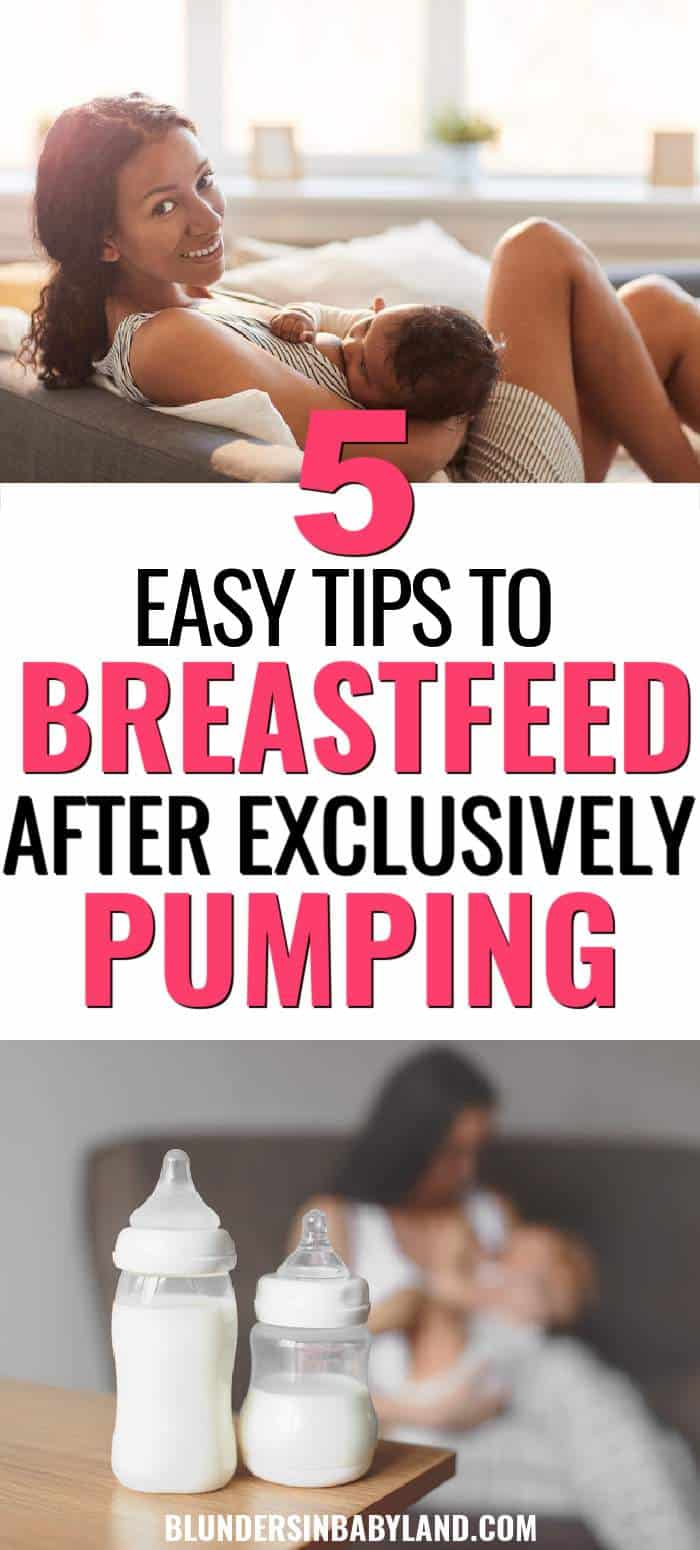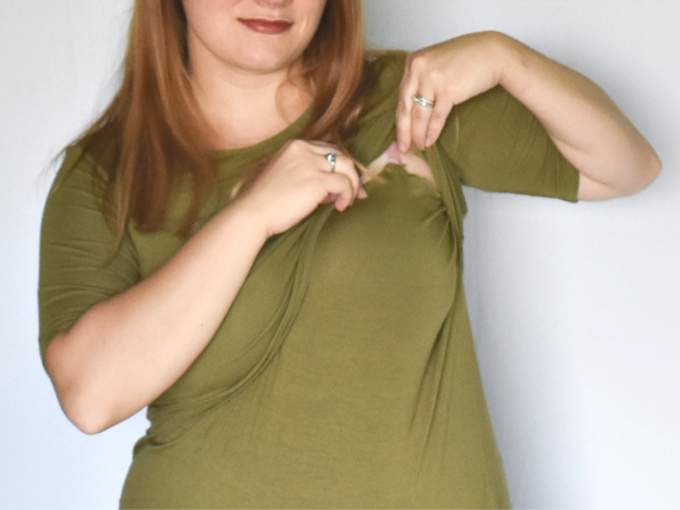5 Easy Tips to Ease Back Into Breastfeeding after Exclusively Pumping
Exclusively breastfeed is the best way to feed a newborn, but there can be several reasons why a new mom is unable to do so.
A lot of babies struggle to latch onto the nipple for the first 10 months. Medical complications like inverted nipple, nipple trauma, plugged ducts also prevent new mothers from breastfeeding. For some women, breastfeeding is simply uncomfortable.
If you have been exclusively bottle feeding so far and are thinking about switching to nursing, let me assure you that it’s not as hard as you think.
It took me about two weeks to wean off exclusive pumping but since everyone is created differently, it can take you anywhere between 1-3 weeks. In this guide, I will walk you through the steps I followed to switch from exclusive pumping to nursing.
Let’s get to it.
RELATED POSTS TO BREASTFEEDING AFTER EXCLUSIVELY PUMPING:
How to Transition from Pumping to Breastfeeding

1. Increase Skin-to-skin Contact
It is scientifically proven that skin-to-skin contact is one of the best things you can do for your little one. Not only does skin-to-skin strengthen your bond, but your skin also passes antibodies to your baby and builds immunity.
For those babies who aren’t naturally good feeders, bringing them closer to your heart will calm them down and get them accustomed to the warmth of your skin and sound of your heartbeat. Beautiful, isn’t it?
Research also says that skin-to-skin contact stimulates a certain part of a baby’s brain, encouraging them to naturally reach for the breast and latch on the nipple for feeding.
Therefore, increasing skin-to-skin contact will ease your baby into breastfeeding from exclusive bottle feeding.
2. Shorten Your Pumping Time
Exclusively pumping can be painful and ridiculously time-consuming. With a single breast pump, you will need to pump for at least 30 minutes to obtain adequate milk for one feed.
Progressively shortening the pumping time will help you let go of the pump faster. If you are going to exclusively pump for a few more months and wish to continue pumping in future, Smilymom.com recommends switching to a wearable double electric breast pump.
These pumps complete the expression in as little as 15 minutes. From these 15 minutes, continue to deduct a few minutes in each session.
Give your body 2-3 days to adjust and after that, continue to shorten the pumping session by a minute or two.
3. Reduce the Number of Pumping Sessions
Another effective way to gradually wean from pumping is to reduce your pumping sessions one at a time. You need to take this really slow. If you abruptly stop pumping altogether, it will most likely lead to painful breast engorgement.
Omitting one pumping session every few days allows your body to adjust to this sudden change in the routine. If you are currently pumping 8 times a day, make it 7 from tomorrow and continue like this for the next few days.
Continue eliminating one session every few days until your body gets used to it. This could take longer if you have overactive letdown. So, don’t worry and be patient.
4. Increase the Gap between Each Pumping Session
The next step on your way to transitioning to breastfeeding is to gradually extend the gap between pumping sessions. Again, the reason for doing this is the same as before – easing your body into breastfeeding.
No matter how well-built your breast pump is, it can never fully replicate the suckle pattern of a human baby.
So, when you have exclusively pumped for a few months, your milk ducts are used to responding in a certain way.
Breast milk is produced on a supply and demand basis. If you pump every three hours, the milk ducts will replenish automatically every three hours.
If you slowly extend the gap by one or two hours until there’s no more milk left to express, you are signaling your body to stop the milk production according to the previous schedule.
5. Ensure a Good Latch
The change isn’t just for you but for your baby too. A bottle is a lot different from a breast. While some babies will acclimatize to it easily, some babies refuse to feed from the breast if they have been bottle feeding for quite some time.
The longer the baby feeds from the bottle, the harder the transition.
If your baby is having trouble latching due to a tongue tie, don’t worry. Most babies grow out of it once their mouth grows bigger. Many babies will become much better at latching once they grow 3 or 4 months old. In the meantime, you can read more about the most effective way to feed a tongue-tied baby here.
For your part in ensuring a proper latch, first, make sure both you and your baby are relaxed while feeding.
Find a suitable feeding position, one that’s comfortable for both parties. Invest in a quality breastfeeding pillow. It will help you snuggle up your little one and effortlessly bring his mouth to the ideal feeding position.
For the first few days, the feeding time might be longer as your milk ducts will be re-adjusting the milk supply to your baby’s appetite.
Also, expect delay in let-down as the baby will also require some time to suckle at a normal rhythm and rate from a breast.
6. Listen to Your Body
How do you know when your body is ready to completely switch to breastfeeding? Take cues from your baby’s reaction. You can tell the baby is well-fed when they slowly release the nipple on their own, unclench their fist, and look relaxed.
Also, don’t forget to listen to your body. If you think your body needs more time to adjust to this change, give it the time it needs. Just don’t give up.
Getting back to breastfeeding from exclusive pumping isn’t a cakewalk but consistency and patience will surely get you there.
7. Keep Both Options Open
Alternatively, you can choose to enjoy the best of both worlds. If you are a working mom, breastfeed at night and on weekends. When that’s not an option, switch to pumping.
Exclusive breastfeeding isn’t the most convenient option for most people. By alternating between two methods, you can let the father or a caregiver be in charge of feeding the baby, when necessary.
Do You Have Any Tips for Learning How to Get Back to Breastfeeding After Exclusively Pumping?
Do what feels comfortable for you. I personally prefer to use both options as necessary. As a working mom, it saves me a lot of hassle and allows my husband to be more involved.
Exclusive breastfeeding is the most effective and hygienic way to feed a baby, without a shadow of a doubt. But let’s admit, it can be too stressful at times, especially if you have a medical condition or a busy work schedule.
So take your time when transitioning from one method to another, listen to your body, and take good care of it.
RELATED POSTS TO BREASTFEEDING AFTER EXCLUSIVELY PUMPING:






